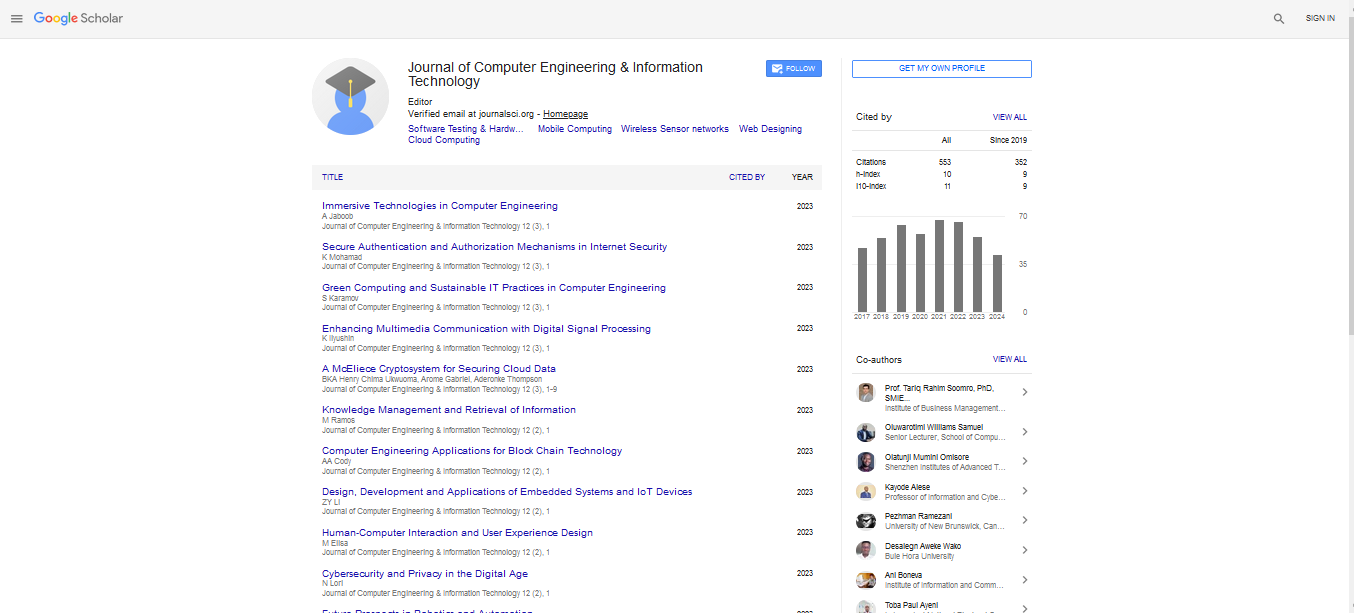Perspective, J Comput Eng Inf Technol Vol: 13 Issue: 5
Optimizing Cloud Infrastructure: Best Practices for Performance and Cost Efficiency
Susanne Zieba*
1Department of Cloud Computing, Reykjavik University, Reykjavik, Iceland
*Corresponding Author: Susanne Zieba,
Department of Cloud Computing,
Reykjavik University, Reykjavik, Iceland
E-mail: susanne.zieba@ru.is
Received date: 13 August, 2024, Manuscript No. JCEIT-24-146806;
Editor assigned date: 16 August, 2024, Pre QC No. JCEIT-24-146806 (PQ);
Reviewed date: 03 August, 2024, QC No. JCEIT-24-146806;
Revised date: 06 September, 2024, Manuscript No. JCEIT-24-146806 (R);
Published date: 13 September, 2024, DOI: 10.4172/2324-9307.1000310
Citation: Zieba S (2024) Optimizing Cloud Infrastructure: Best Practices for Performance and Cost Efficiency. J Comput Eng Inf Technol 13:5.
Description
As organizations increasingly migrate to cloud computing environments, optimizing cloud infrastructure for performance and cost efficiency has become essential. Cloud services offer flexibility, scalability and reduced capital expenditure, but without proper management, costs can quickly escalate and performance can suffer. This discuss best practices for optimizing cloud infrastructure, focusing on achieving both high performance and cost efficiency. Optimize database performance by choosing the right scaling strategy. Use vertical scaling (increasing instance size) for smaller databases and horizontal scaling (sharding or clustering) for larger, distributed databases. Implement database indexing, query optimization and caching to enhance performance. Consider using managed database services offered by cloud providers. Managed databases, such as Amazon RDS or Azure SQL Database, provide automated backups, scaling and maintenance, allowing you to focus on application development while benefiting from optimized database performance.
Hold cloud cost management tools to monitor and analyze your cloud spending. Tools such as AWS Cost Explorer, Azure Cost Management and google cloud billing provide insights into usage patterns, cost allocation and budget tracking. Use these tools to identify cost drivers and optimize spending. Set up budget alerts and controls to track spending and prevent overspending. Configure alerts to notify you when costs exceed predefined thresholds and implement controls to enforce budget limits and approval workflows for resource provisioning. Purchase reserved instances to save on long-term costs. Reserved instances offer significant discounts compared to ondemand pricing for committing to a specific instance type and region over a one- or three-year term. Analyze your usage patterns to determine the optimal number of RIs required. Consider cloud provider savings plans for flexible cost savings. Savings plans allow you to commit to a specific amount of usage (e.g., compute or storage) for a one- or three-year term in exchange for discounted rates.
Savings plans offer more flexibility than RIs, as they apply to a broader range of services and instance types. Regularly review and adjust resource allocation to match current needs. Utilize cloud provider tools and third-party solutions to analyze resource utilization and identify underutilized or over-provisioned resources. Resize or terminate instances as needed to align with actual demand. Take Advantage of Spot (AWS) or pre-emptible (google cloud) instances for cost savings on non-dire workloads. These instances offer significant discounts compared to on-demand pricing, but they may be interrupted based on availability. Use them for batch processing, development, or testing environments. Configure lifecycle policies to automate data management and reduce storage costs.
Policies can automatically move data to lower-cost storage tiers, delete expired data, or archive infrequently accessed data. This helps optimize storage costs while maintaining data accessibility. Regularly review and clean up unused or redundant data to minimize storage costs. Implement deduplication and compression techniques to reduce the amount of storage required for your data. Minimize data transfer costs by optimizing data movement between regions and services. Use services with built-in data transfer optimizations, such as cloud storage transfer acceleration or inter-region data transfer discounts, to reduce costs associated with large data transfers. Establish private network connections, such as AWS Direct Connect or azure express route, to reduce data transfer costs and improve network performance. These connections offer lower data transfer rates compared to public internet connections and provide enhanced security and reliability.
Conduct regular performance reviews to ensure that your cloud infrastructure is meeting performance objectives. Use monitoring and analytics tools to track Key Performance Indicators (KPIs), identify performance bottlenecks, and make necessary adjustments. Perform periodic cost audits to identify areas of potential savings. Review historical spending data, assess resource usage patterns and adjust resource allocations and purchasing decisions accordingly. Solicit feedback from stakeholders and end-users to identify areas for improvement. Continuously optimize your cloud infrastructure based on performance metrics, cost analyses and user feedback to achieve ongoing improvements in both performance and cost efficiency.
Optimizing cloud infrastructure for performance and cost efficiency is essential for maximizing the benefits of cloud computing. By implementing best practices such as right-sizing resources, optimizing storage and network performance, influencing cost management tools and adopting cost-effective pricing models, organizations can achieve a balance between high performance and cost savings. Regular monitoring, continuous improvement and effective resource management ensure that cloud infrastructure remains aligned with organizational goals and delivers optimal value. As cloud technology continues to evolve, adopting these practices will be essential for maintaining a competitive edge and achieving long-term success in the cloud.
 Spanish
Spanish  Chinese
Chinese  Russian
Russian  German
German  French
French  Japanese
Japanese  Portuguese
Portuguese  Hindi
Hindi 